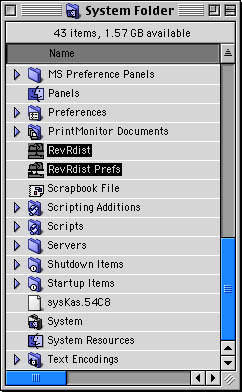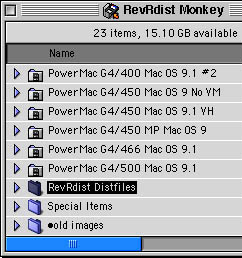General Info
By: Mike Kimball - Revised: 2006-06-28 devinIntroduction
General information about RevRdist, how it works, uses, and strategies.Section Links
About RevRdist
RevRdist (pronounced "rev-are-dist") is a freeware hard disk management utility for Macintosh, written by Dale Talcott of Purdue University. RevRdist restores individual hard disks to a configuration specified by the lab administrator, by comparing the local hard disk volume to a master folder (usually located on a network volume), and then correcting any differences on the local volume according to the instructions in the distribution control file ("distfile").RevRdist does not prevent users from modifying the contents of the hard disk. It does not affect the normal operation of the Mac in any way. Instead, you run RevRdist at startup, shutdown, or other convenient time to restore the volume to its desired configuration.
No part of the RevRdist program actually runs on the file server itself - the file server simply stores the files that RevRdist accesses. Furthermore, contrary to what was reported in MacWEEK, RevRdist is not a program for UNIX servers. RevRdist is a Mac application and will run in a 100% Macintosh environment.
For more information about the application and its operation, visit the RevRdist home page, http://www.purdue.edu/revrdist. (link dead)
How It Works
 Client
Client"Client" simply means the user machine that you want to synchronize using RevRdist. There are only two items needed: the RevRdist application and its Prefs file. These usually reside in the Startup Items folder, but we put them in the root of the System Folder in order to run on demand as well as at a scheduled time.

 Server
ServerThe server is where most of the important items reside. Below you see the different "images" (master folders for each type of machine), the RevRdist Distfiles folder (to contain all the directives files), and the Special Items folder (to contain all applications and other software to be installed).

Purposes/Uses
RevRdist's chief power is in installing and maintaining machines that are used in an open-access lab environment. When you have, say, a classroom of 30 G4's which have to be configured alike, it's not a lab administrator's preference to set up every machine individually; running every application installer, configuring all the control panels, etc... Further, we all know a cardinal rule in IT support: users break stuff. In an open-access lab, they not only cause problems, but they often do not report them. They install software that we do not want on the machine permanently, they install software that is already on the machine, they use Napster to fill up the hard drive with all kinds of (Metallica) junk...With RevRdist, you don't have to spend days installing machines, you don't have to waste hours firefighting, and you don't have to go around cleaning them up. A machine can be initialized, OS installed, and RevRdisted to full strength in 30-40 minutes. Since most of this is done by clicking a button and then walking away, you could have a whole room of machines out of the box and up and running within hours. From then on, most normal problems will be automatically fixed every day when RevRdist does its job. The machines start fresh on a daily basis, and the lab administrator has time better spent elsewhere.
More important, the stability and consistency of your machines will make the users happy.
Strategies
BasicThis strategy involves putting all of the system software and applications that each machine will use into a single master image. This "single master image" is basically a folder that contains all items that the client will use and clone. We recommend this when you have a limited number of machines, a limited number of different configurations, or perhaps if you want to get a lab up and running on RevRdist quickly without an immediate and steep learning curve.
- Distfile: simple set of instructions, little special code.
- Server Image: usually a single folder - a universal system containing all system software, all application software, basically everything configured exactly as it is to be cloned
Disadvantages: Configuration is not streamlined for particular machine type, updates are not easily reversible.
Advanced
Our advanced strategy involves separating all application software into a "Special Items" folder, from which to be distributed through extra instructions in the distfiles. We also use individual master images for each type of machine and/or lab location, rather than one universal system image. This method emerged when our territory expanded, including many different configurations, many machines, and many locations.
- Distfiles: complex sets of instructions, each tailored to a particular machine configuration, with frequent use of special code and calls to items in the Special Items folder.
- Server Images: several folders - each is configured for a particular machine model and contains only the system software that is needed by every machine that uses that particular image folder.
- Special Items: a folder hierarchy on the server - contains all application software including all according system components, distributed to machines through code in the distfile that specifically calls these items.
Disadvantages: longer initial setup time, larger learning curve.
- Documentation
- Administration
- Authentication
- General Software
- Hardware
- Miscellaneous
- Multimedia
- Networking
- Operating Systems
- Outside Presentations
- Programming & Scripting
- Security
- Servers
- Short Courses
- System Deployment
- System Utilities
- What's New

